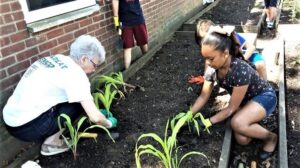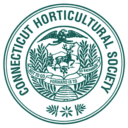History
Connecticut Horticultural Society: Established in 1887
Dedicated to encouraging and improving the practice of gardening and the dissemination of horticultural information to its members and the public. The Society through its many and varied programs seeks to encourage the enjoyment, appreciation and understanding of plants, the environment, and the art and science of gardening.
1887 ~ A group of estate gardeners begin to meet on a regular basis to exchange ideas and best practices (and perhaps to brag!) over a pint. Membership: 78. Assets in 1887: $ 68.19. (They grow to $1400 by 1896.)

1889 ~ By special act of the General Assembly, the Hartford County Horticultural Society is incorporated. With the likes of H.H. Hale (“Glastonbury’s Peach King”), J.C. Webster, George Atwood and others as members, meetings are held at a municipal building in Hartford.
1890 ~ Horticultural Society president John Webster speaks timeless truth: “…Horticulture in its various branches does not reward in dollars and cents like other industries but in elevating the mind, giving healthful occupation and improved living… I pity a man or woman who cannot see in beautiful flowers God’s handiwork; who can only value them for the money they will bring. We all know that a home is more attractive, and if put upon the market would bring a better price, if surrounded by a well lawn and handsomely decorated with plants and shrubs.”

1896 ~ The first claim that fossil fuel combustion may eventually result in the natural greenhouse effect is made by Svante Arrhenius (1859-1927). A Swedish scientist, he proposes a relation between atmospheric carbon dioxide concentrations and temperature. He finds that the average surface temperature of the earth is about 15 degrees C because of the infrared absorption capacity of water vapor and carbon dioxide.
1898 ~ 700 acres in the north end of Hartford is designed and developed into Keney Park. The Olmsted Brothers Landscape Architects guiding philosophy is “to preserve and to encourage wildness of vegetation, planting only native trees and shrubs…”

1907 ~ Kalmia latifolia, the Mountain Laurel, becomes Connecticut’s official flower.
1911 ~ It is reported that at a Connecticut Horticultural Society (CT Hort) meeting, the Secretary addressed the group stating that Eve could not have tempted Adam with an apple – but it might have been a pear.
1900 ~ For 5th year in a row, late frost obliterates peach buds & CT Ag director declares “let the south grow peaches.” Apples become the crop of the future for Conn. More than 60 varieties are grown here today.
1924 ~ John C. Willard of Comstock-Ferre becomes president and Samuel Deming of Elizabeth Park becomes secretary. The first woman member – Ms. Annie Lorenz – joins. Her library is purchased by Mrs. E.K. Root and donated to start the Society’s library.
1930 ~ Flower shows become popular. Dahlias and Chrysanthemum shows are held regularly at the Old State House. The Hartford Florists Association holds 2-3 shows at the State Armory with great success. As a result, many more women become involved. CT Hort follows suit.
1932 ~ Lafayette Robertson is in charge of the Society’s show. Failed publicity and participation drains the Society’s assets of $4000. Thanks to by-law changes, and fundraising by the Ladies Corps who holds flower sales and membership drives for three years running, the society’s asset are restored.
1940 ~ J.I. & Anna Rodale buy a farm in Emmaus, Penn.; become acquainted with and excited about botanist Sir Albert Howard’s ideas on the connection between soil and health . They transform their property into a working organic farm with gardens dedicated to early organic research experiments.
1943 ~ Labor and gas shortages during the war years mean that both harvesting and shipping food to markets is difficult. The government’s solution is to call on citizens to plant Victory Gardens so families could become more self-sustaining… “A garden will make your rations go further” and “Our food is fighting.” The public springs into action. Urban rooftops, backyards and empty lots become gardens and suburban vegetable gardens are enlarged, all in the patriotic effort.
1952 ~ Genevra Goodwin of West Hartford becomes a member and remained a member until her passing in February, 2020.
1954 ~ David Smith, later CT Hort president, arrives in USA from the UK. As director of Horticulture at White Flower Farm, he puts his personal stamp on the growth of Litchfield’s premier nursery and garden mail-order business for the next 36 years.
1957 ~Africanized honey bees escape a Brazilian lab and migrate north. By 1990, these “Killer Bees” panic the public with rumors of aggressive swarming.
1959 ~ UConn students of horticulture become the beneficiaries of annual scholarships from CT Hort. Members raise funds throughout the year with raffles, auctions and plants sales.

1962 ~ Rachel Carson’s “Silent Spring” is published. It exposes the harmful effects of pesticides and other pollutants on the environment and wildlife. It is considered the inspiration for the environmental movement.

1963 ~ CT Hort President Walls Bunnell of Farmington donates quarters to house the 1000+ books and pamphlets that have been in scattered storage around Hartford. Many books had been lost in the flood of August 1955 when a Trinity College basement was inundated. Finally, the important collection would be in one place: the W.W. Bunnell Library in Farmington, Conn.

1965 ~ Nancy & Bob Shipman, of Glastonbury’s Shipman Nursery, join CT Hort and use the Thursday evening meetings as a date night… for the next 58 years, until Bob’s passing in early 2024. Nancy is the Society’s longest-standing member.
1972 ~ In September, Walter Cronkite reports the coming of the “New Ice Age”, and warns that temperatures will decrease continually for the next 10,000 years, according to scientists.
1975 ~ John C. Willard, (CT Hort President, 1924) explains in retrospect, “Books without number have been written and are available to even the rankest amateur, but nothing takes the place of talking with the kind of down to earth gardeners that [attend our] meetings.”
1977 ~ Friendship Tours launches a premier garden related travel program with CT Hort. Guided by beloved Lois Isaacson, it takes us around the world visiting exquisite private and public gardens along the way.

1987 ~ In our 100th year of educating gardeners, the Mehlquist Award is established to recognize a Connecticut plantsman or woman who has had an impact on the art of gardening or has made an extraordinary contribution to the world of horticulture. The honor is named for CT Hort member Gustav A.L. Mehlquist (1906-1999), a world-renowned plant breeder and beloved UConn professor. Click here to see the list of Mehlquist winners.
1998 ~ The Giving Tree: a FUNdraising campaign brings in $30,000 for CT Hort to move its office & library to Rocky Hill.
2004 ~ “Like the 17th century gardeners who knew they could never recapture Eden, I know that, by gardening, I can never recapture the earth as it was before man tampered with it. But it is the closest I can get.” Rea Lubar Duncan, (1920-2004) New York Times writer, CT Hort member, and columnist.

2010 ~ Plant Explorer & horticulturist Dan Hinkley is our keynote speaker for the biennial Spring Symposium. “Stop following the rules… none exist for your own garden – (it) is a personal odyssey. I would no sooner hire someone to design my garden than raise my children. All the entertainment you will ever need is right outside your back door.”
2010 ~ The CT Hort Board of Directors votes to offer scholarships to students in the horticulture program at Naugatuck Valley Community College (NVCC).
2012 ~ The USDA adds zone 7a to Conn.
2013 ~ Nurseryman Dick Jaynes of Broken Arrow Nursery, Hamden is honored by CT Hort with a scholarship in his name to be given to a NVCC horticulture student each year.
2014 ~ Celebrating 55 years of scholarship giving CT Hort invites scholars back. Members hear about scholars’ successes in horticulture and the impact of their CT Hort scholarship. At UConn, three namesake scholarships are awarded annually: Ludwig Hoffman, David J.A. Smith, and Pat Carpenter.
2020 ~ The Covid pandemic creates an international shutdown of unparalleled proportions. Zoom technology provides a way to meet remotely and continue our speaker programs, instituting a new hybrid option of both in-person and virtual options for speakers and workshops. CT Hort takes advantage of this new way to promote its educational mission. The pandemic also spurs the CT Hort office to become fully remote. Good homes for the items in our book collection are found with Bartlett Arboretum, Connecticut College, The CT Botanical Society and Naugatuck Valley Community College.
2022 ~ CT Hort celebrates 135 years of educating gardeners, Friendship Tours reaches 45 years of fabulous garden adventures with CT Hort. We have communicated our Mission at more than 40 commercial flower shows across the years. Thousands have attended our hands-on workshops, symposiums and monthly program meetings. We look forward to our next 135 years.

2023 ~ The CT Hort Board of Directors approves the formation of a Civic Projects Committee to administer a grant program for community projects throughout the state with an emphasis on the importance of plants and our environment. $2,500 in grants were awarded in 2023 with plans to award $5,000 per calendar year going forward.
2024 ~ The CT Hort Board of Directors, realizing it needs to take the organization to the next level in terms of member recruitment and pursuing its mission to educate the public on horticulture, hires its first Executive Director, Ashley Stewart.
